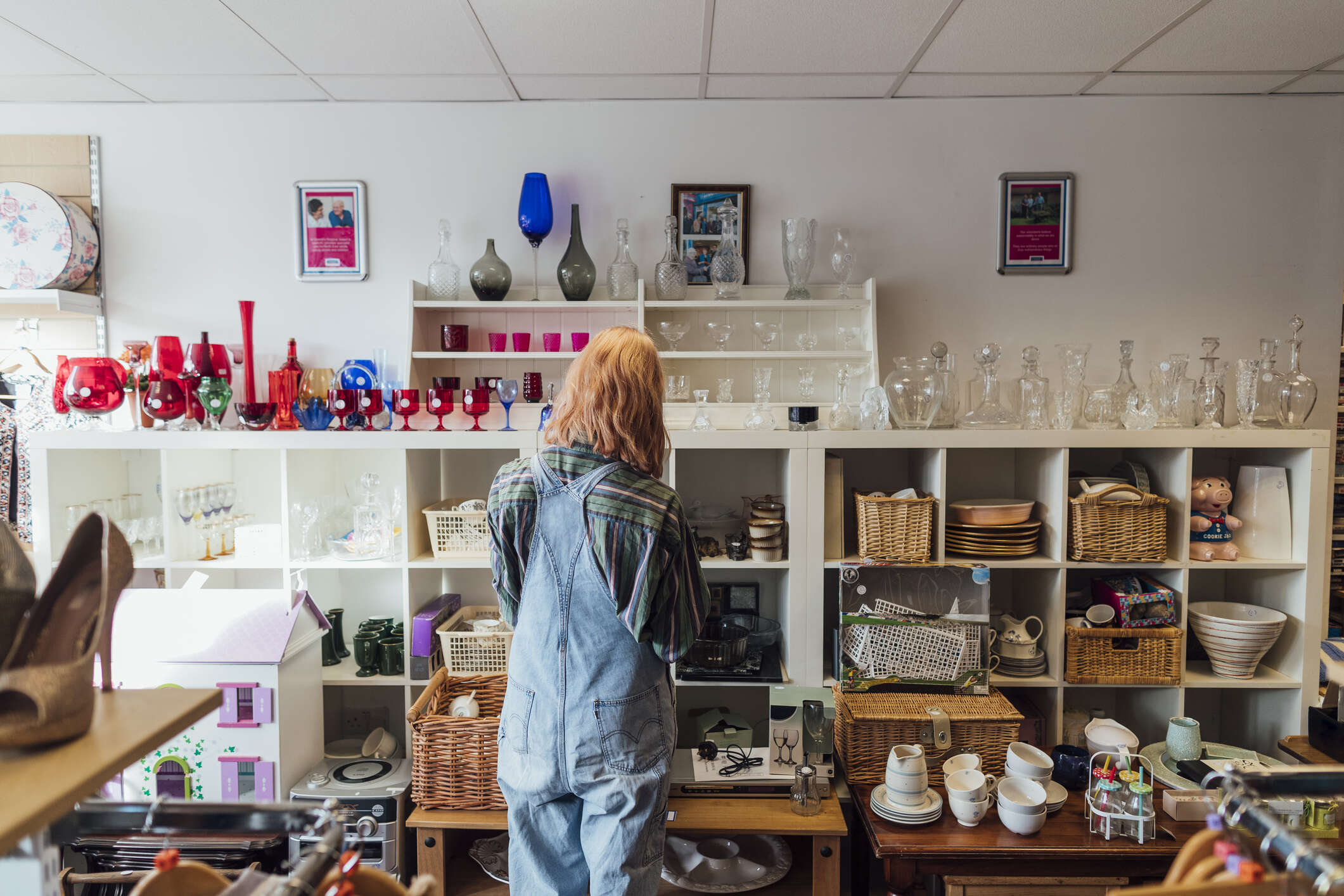
The record was never meant to be sold in the first place. One of 250 promotional singles handed out to DJs in radio stations in 1963, the 7″ vinyl showcased the talents of a band whose songs had been heard more inside packed bars and clubs in Hamburg than they had on British airwaves. As such, the single’s title, ‘Love Me Do,’ would have seemed just as unremarkable to the disc jockeys surveying the white-labelled EP as the names of the vocalists, ‘Lennon and McArtney.’
Despite the misspelling of McCartney’s name, the Beatles would go on to mould popular music into what we know today. A copy of the promo record, meanwhile, would languish in obscurity before being anonymously donated to a charity shop in Midhurst, West Sussex. Discovered in 2019 inside a plastic shopping bag alongside 25 other vinyl discs, staff at the British Heart Foundation outlet realised its potential and passed it along for sale online – where it was eventually sold on the charity’s eBay channel for £9,400.
It’s just one example of how an online presence can allow a truly valuable donation to reach the widest possible audience, explains the BHF’s retail director Allison Swaine-Hughes, and a major reason why charities are now embracing the potential of online marketplaces. “It means that we can not only grow our channels to realise [the] value of the things we’re given,” says Swaine-Hughes, “but we’re also growing how people can give us stuff, whether they be corporate partners or individuals, as well.”
That potential was laid bare during the pandemic. “The closure of retail for that period of time had a significant impact, because obviously we’re a large-scale estate,” says Swaine-Hughes. BHF’s network of 740 shops contributes up to a third of the £100m the charity raises annually for research into cardiovascular diseases. As such, last year was the charity’s ‘recovery year,’ says its retail director. “We had a phenomenal performance last year, way above all our expectations, and that momentum from the retail estate…has continued into this year,” Swaine-Hughes says.
Sales from online marketplaces played a major part in that recovery for the BHF, as they did for many other charities. One recent survey of the sector found that 82% of charities considered a digital strategy to be more important since the pandemic, with almost three-quarters now delivering services via Facebook, Slack or Zoom. As more charities such as Barnardo’s, Oxfam, Cancer Research UK and others embrace the potential of online marketplaces too, however, new questions naturally emerge about the future of their physical retail estates – including the charity shop itself.

Secondhand marketplaces
Next month, a birthday party is being held inside a nondescript property on Broad Street, Oxford. “It will be a celebration of our first charity shop,” explains Oxfam’s e-commerce and retail innovation director, Andy Ostcliffe. Opened in 1947, sales from the site were originally intended to support famine relief efforts in Greece after the Second World War.
It may not have been the first of its kind – the Salvation Army was selling secondhand clothing in dedicated shops in the Victorian era – but Oxfam’s boutique on Broad Street helped to change British retail forever. Charity shops are now a fixture of our high streets, a place where millions of people can easily, almost unthinkingly, support their organisation of choice through donations, or shop for assorted clothing and knick-knacks they wouldn’t find anywhere else.
In recent years, they’ve even become fashionable. “It’s actually quite trendy to go and find something at the moment and wear it and get a comment from your friends to say, ‘Well, I like your shirt,’ or, ‘I like the dress,’ or, ‘I like the hat you’re wearing, where did you get that from,’ and to answer, ‘Oh, I got it from a charity shop,’” says Ostcliffe. “It feels good.”
Browsing in a charity shop is also the most analogue experience one will encounter on the high street. Short of ringing staff ahead of time, there is no knowing whether the shop is accepting donations, let alone the variety of stock on the shelves. While that unpredictability forms part of the innate appeal of walking into a charity shop, the lack of an online donation or sales component until recently has limited the variety and resale value of the goods each property acquires.
It was with this problem in mind that Oxfam opened its first online shop in 2007. Like other major charities, it has since expanded that centralised marketplace on its website into partnerships with the likes of Depop, eBay and Shopiago. These relationships proved their worth during the pandemic – especially during the run-up to Christmas in 2020, when Oxfam witnessed a 90% increase in online sales.
Selling an item on one of these sites, however, isn’t as simple as it seems. At the BHF, explains Swaine-Hughes, each donation undergoes a rigorous quality control process. “There are other items that might be unique and need research,” she says. “They might have certain branding that we want to make sure is authentic, so that we realise the right value. We have a specialist operation up in Leeds that has expert listers that can assess all of those things.”
Charities also need a more catholic approach to marketing their wares than other retailers. While Oxfam’s online shop attracts up to 1.5 million visitors annually, explains Ostcliffe, the charity realised early on that it could radically expand its reach by advertising on other marketplaces. “That’s where the traffic numbers are, that’s where the big corporate tech companies are,” he says.
This is one of the reasons why eBay has proven such a boon for major charities. Both Oxfam and the BHF maintain sizeable presences on the site. Not only are the traffic numbers for eBay far in excess of anything either charity would see on their own websites – the site boasts 22 million active users in the UK alone – but it’s also a great way for many of the more eclectic donations to be sold at their true market value. “Some of those things wouldn’t fit, and wouldn’t be right, in our shops and stores,” says Swaine-Hughes.
Partnerships between Oxfam, BHF and Shopiago have also drastically increased the reach of both charities by allowing listings for a single item to appear on multiple platforms. “Historically, our 700 sites would look at items, decide what goes up to our specialist unit, and that would be it,” says Swaine-Hughes. “What Shopiago did is allow BHF to continue to do that, but now for our 700 locations to list, also. “So, whereas we might have listed between 5,000 and 6,000 items a week, we’re now beyond 7,000-8,000 items we can actually list.”

Expanding online reach
Expanding online isn’t just a way to grow the reach of secondhand donations. Both Oxfam and the BHF have also used such marketplaces to expedite the sale of new product ranges tied to their cause. In the case of Oxfam, that’s Fairtrade goods worth more than £13.5m, explains Ostcliffe.
BHF expanded its range to medical devices, too. Swain-Hughes says this was a bid “to really connect to our cause”, and as a result, a visit to the BHF online store will reveal not only secondhand donations from the public, but also brand-new blood pressure monitors and defibrillators. That market, says Swaine-Hughes, “has seen significant growth as people seek to take care of themselves at home”.
BHF is also focusing on how to use its online presence to market its ability to take different types of donations. Few people, for example, would immediately think that their tables, chairs or old sofa would be suitable for donation to their local charity shop. By donating these items to charities like BHF for sale online, however, donors can give such furniture a second life while funding research into cardiovascular disease.
“Last year, we saved 57,000 tonnes of goods from going to waste,” says Swaine-Hughes, including 13,000 tonnes of premium clothing and approximately 103,000 sofas. “We specialise in re-use, and I think re-use in the market overall is absolutely fundamental.”
Perhaps unusually, BHF and Oxfam do not have partnerships with the biggest online marketplace in the game, Amazon. That, says Swaine-Hughes, is down to the current policy the retail giant has in listing fees for charities. Even so, she adds, conversations with the platform are ongoing, and the BHF continues to benefit from Amazon’s ‘tithing’ funding channel, which allows individuals to contribute a portion of the fee they might pay for an item to a charity of their choice.
Tithing creates a new revenue stream without necessarily creating a strong relationship with a single platform, she adds, and is becoming increasingly common. “You’ll see it on Vinted now, you’ll see it on eBay, you’ll see it on Amazon,” says Swaine-Hughes.
Will online marketplaces lead to the death of physical charity shops, much like they’ve lain waste to the rest of our high streets? Swaine-Hughes thinks not. If anything, the experience of BHF over the past two years has illustrated the importance of these brick-and-mortar shops to the fundraising capability of the charity.
“The estate, the shops and stores, the reason they’re so fundamental is they gather the treasure,” says Swaine-Hughes. When it comes down to it, they remain the most practical entry point for hundreds of thousands of items, some with vast resale potential.
Charity shops are also destinations in themselves, says Ostcliffe, not only because they’re affordable but also because of their eclectic stock. The Oxfam e-commerce chief considers the example of another major charity in the sector that recently set up drive-through donation stations in the UK. “They suddenly found a lot of their customers saying, 'Oh, can we pop in and have a look around and see what there is to buy?” he says.
As such, automation in the charity sector is never going to be a simple story about how sales in digital marketplaces will, eventually, see physical stores withering on the vine. “The benefit of online isn’t necessarily replacing sales of the shops,” says Swaine-Hughes. In the end, she explains, what these stores are doing is “maximising value and exposing it to a wider audience. That’s the key piece here. That’s really what our online expansion is about”.






